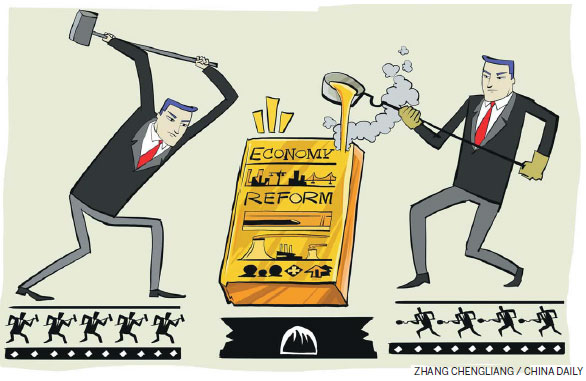Riding a wave of investments
Updated: 2015-03-20 07:36
By Yifan Hu(China Daily Europe)
|
|||||||||||
Measures will stimulate both domestic and overseas infrastructure funding
China recently concluded its two sessions that this year focused on the nation's so-called new normal model of economic growth, set a 2015 GDP growth target that is lower than last year's (to 7 percent from 7.5) and laid out specific measures and policies for deepening reforms amid a slowdown. This is a crucial year for further deepening and implementing reforms, including changes to the financial sector, to fiscal policy and for state-owned enterprises.
Investment will continue to be the major driver of growth. The traditional three drivers of China's economy are exports, consumption and investment. Yet there are significant headwinds for two of these drivers. First, China's exports are losing their vigor. Internal and external demand remains weak, dragged down by energy and commodity prices. China's January exports and imports both slid to negative growth this year.

On the other hand, although the renminbi is expected to depreciate against a strong US dollar, the nominal effective exchange rate - essentially the value of a country's currency in relation to a pool of major currencies - and the real effective exchange rate of the renminbi continue to rise. These factors imply that pressure on exports should persist in 2015. The Ministry of Commerce recently adjusted the 2015 export growth target to 6 percent from 7.5 percent in 2014.
But consumption remains weak, impacted by the overall economic deceleration and the central government's anti-corruption measures. Investment thus continues to play an active role in supporting growth amid structural reforms.
Most local governments held their local two sessions and announced their 2015 growth targets earlier this year. Most provinces aim to grow by more than 7 percent in 2015, but well below their 2014 levels.
They also set 2015 investment targets, which while lower than in 2014 are still above 15 percent and well above the GDP growth target, indicating that investment will continue to support growth in 2015.

Investment this year will be marked by two characteristics. First, central fiscal spending is likely to increase heavily after responsibilities for both the central and local governments were redefined and as the central government pushes for more public-private partnerships on public projects. Second, the "One Belt, One Road" strategy will stimulate both domestic and overseas infrastructure investments. Investments in infrastructure, emerging industries, healthcare and retirement services and the "One Belt, One Road" initiatives will advance growth this year.
There is a notable disparity between central and local governments in China regarding the distribution of revenue and expenditures. In general, China's central and local governments equally share tax revenues, but the proportion of spending is heavily in favor of local governments. Along with the implementation of the new Budget Law, local financing will be more strictly regulated and transparent. Coupled with tight controls over the shadow banking industry and the mounting debts of most local governments, investment initiatives and capability will be impaired this year and financing channels for local governments increasingly limited. Given the revenue structure of the central and local governments, more investments will be shifted under the authority of the central government.
Partnerships between public and private sectors could help relieve the financing pressure on local governments and cut down on the number of inefficient investments. The public-private partnership model can be a solution to the local government debt issue without increasing leverage. Both domestic and foreign investors can participate in such projects, which can be attractive to both governments and the private sector given the risk-sharing model and potentially stable revenue streams.
Allowing the participation of private capital in monopolistic industries was emphasized at the Third Plenary Session of the 18th CPC Central Committee. Sectors including telecommunications, high-speed railways, subways and banking are expected to allow private capital investment. The partnership model could improve operational efficiency, reduce costs and promote innovation and competition, potentially enhancing the role of investment in promoting economic growth.
While the total investment amount for new infrastructure projects - valued by the media earlier this year at 7 trillion yuan ($1.1 trillion) - has not been confirmed, it is an important reference point.
It has been reported that investments in 2015 will cover 420 projects, including food and water conservation, transportation, environmental protection, healthcare, information networks, clean energy, oil and gas and mineral resources. This will not only stabilize growth but also aid in structural reform, and help support emerging industries while improving traditional sectors. Ultimately sustainable growth will be achieved.
Local governments have been actively promoting infrastructure investment to realize regional economic integration, making it the main engine of growth at the provincial level and pushing up fixed asset investments. Western provinces have emphasized roads and railways in their transport infrastructure investment this year. Specifically, western regions have emphasized roads and railways with total investments of up to 600 billion yuan. For Yunnan and Sichuan provinces and the Guangxi Zhuang autonomous region, transportation-related investment will reach up to 100 billion yuan in each province, while the Xinjiang Uygur autonomous region, and Shaanxi, Gansu and Qinghai provinces as well as Chongqing will each invest from 25 billion yuan to 80 billion yuan in infrastructure.
China is pushing for fiscal and industrial policies to work cohesively to support emerging and strategic sectors, including high-end manufacturing, new energy, information technology and the ultra-high-voltage grid to help industries upgrade.
The cities of Beijing, Shanghai and Tianjin and Zhejiang province will further promote technological innovation and industrial upgrades. Zhejiang, for example, will accelerate the construction of smart cities. Shanghai will be proactive in integrated circuits and big data to create "a global technology innovation center".
Sectors including healthcare, retirement services and the environment will be highlighted to not only stimulate domestic demand but also improve the quality of life.
The Chinese economy has recently been characterized by excessive savings and credit, which has led to overcapacity. Fostering overseas investment, and infrastructure projects in particular, can help the Chinese government tackle this issue. Sectors such as cement, metallurgy, and construction that are closely related to infrastructure projects are suffering from overcapacity. Using these resources abroad can be an efficient way to rein in a significant amount of overcapacity and facilitate the implementation of structural reforms. Moreover, credit and excess savings can be channeled abroad, reducing incentives to finance unviable companies or projects. Finally, competition between foreign and domestic actors to access funding is likely to lead to a better allocation of capital.
The "One Belt, One Road" strategy proposed in September 2013, in which 19 provinces laid out their infrastructure plans and overseas expansion opportunities aimed at high speed railways, intercity railways, subways, airports and ports, could accelerate regional economic integration and resolve domestic overcapacity. We expect more detailed measures in the "One Belt, One Road" initiatives to be announced after the two sessions.
Specifically, the "One Belt, One Road" strategy concentrates on emerging and developing countries, with a total population of 4.4 billion and economic scale of $21 trillion. The implementation of the strategy will not only enhance traffic conditions, but also deepen economic and trade relations.
Within the "One Belt, One Road" initiatives, China will be involved in numerous high-speed railway projects globally. The Kunming-Singapore line will stretch out over 3,000 km and is worth over $100 billion. It started in 2011 and will be completed by 2019. Construction on the Vientiane-Bangkok and Bangkok-Kuala Lumpur lines, totaling 1,400 km with a total budget of $23 billion, will begin this year and be completed by 2022.
The author is the chief economist at Haitong International in Hong Kong. The views do not necessarily reflect those of China Daily.
(China Daily European Weekly 03/20/2015 page12)
Today's Top News
Manhunt launched for accomplices in Tunisian museum attack
Chanel to reduce prices in China
Russian FM slams Kiev for turning Minsk agreements 'upside down'
European chamber calls on China to boost reforms
Chinese firm takes stake in French airport
Putin slams attempts to rewrite WWII history
EU police group launches team to tackle migrant smugglers
Britain needs oil tax cuts to attract North Sea investment
Hot Topics
Lunar probe , China growth forecasts, Emission rules get tougher, China seen through 'colored lens', International board,
Editor's Picks

|

|

|

|

|

|





